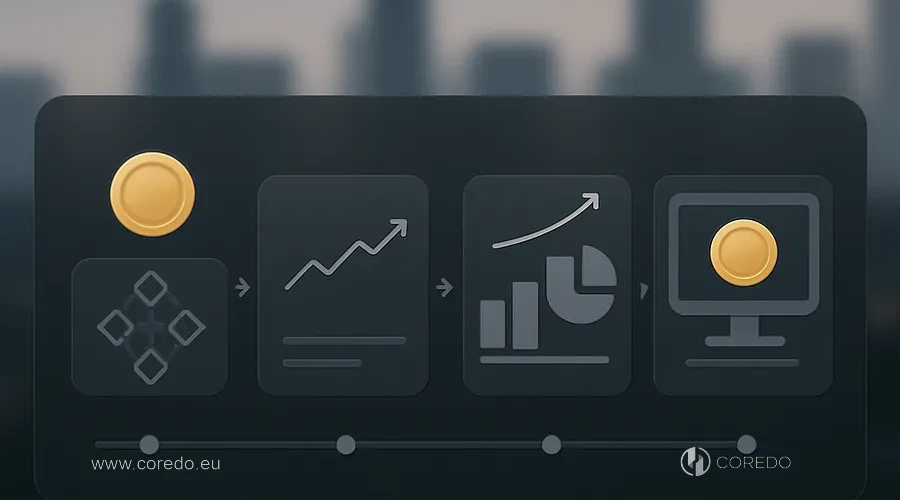In 2025, more than 60% of large companies from Europe, Asia and the CIS are considering creating a cryptocurrency or integrating blockchain solutions into their business processes. According to Messari, in the past 12 months alone the number of corporate crypto projects has grown by 40%, and the amount of investments attracted to the sector has exceeded $30 billion. But why, despite the obvious advantages — from optimizing settlements to access to new capital markets — do less than 10% of these initiatives reach a successful launch of their own cryptocurrency?
How to structure a project to avoid strategic mistakes, register a cryptocurrency in the EU or Asia, comply with regulatory requirements and ensure the security of the blockchain ecosystem? I, Nikita Veremeev, founder of COREDO, share in this article a practical step-by-step guide based on our team’s experience in implementing dozens of international crypto projects.
How to create your own cryptocurrency

At the core of any crypto project is the choice between two strategies: developing your own coin with a separate blockchain or creating a token on an existing platform such as Ethereum, BNB Chain or Polygon. My experience shows: for most business cases, especially at the start, it is optimal to use tokenization on mature blockchain platforms: this reduces costs, speeds up the launch of your own cryptocurrency and simplifies integration with DeFi protocols and exchanges. However, for projects where customization, privacy or a unique consensus protocol are critical, developing a native blockchain is appropriate.
A crypto project’s roadmap usually includes the following stages:
- Formulation of the concept and business model (utility token vs security token)
- Design of tokenomics and technical architecture
- Selection of the blockchain platform
- Legal structuring and Licensing
- Development and audit of smart contracts
- Integration of AML/KYC procedures
- Preparation of the whitepaper and roadmap
- Launching ICO/IEO/STO (if necessary)
- Token listing on exchanges and scaling
| Stage | Key tasks | Example from COREDO |
|---|---|---|
| 1. Analysis of goals and market | Assessment of business objectives, target audience, risks | Case: launch of a utility token for e-commerce in the EU |
| 2. Choosing the type of cryptocurrency | Coin or token, choice of standard (ERC-20, BEP-20) | Launch of a BEP-20 token for a fintech startup in Singapore |
| 3. Tokenomics development | Supply cap, emission schedule, incentive mechanisms | Project: implementation of a governance token for a DAO |
| 4. Legal structuring | Registration of a legal entity, licensing, tax compliance | Registration of a VASP in Estonia |
| 5. Smart contract development | Programming, testing, audit | Smart contract audit for a DeFi platform |
| 6. AML/KYC integration | Implementation of procedures, choice of provider | Implementation of KYC for an STO project in the Czech Republic |
| 7. Documentation preparation | Whitepaper, roadmap, legal opinion | Preparation of the whitepaper for an ICO in Slovakia |
| 8. Launch and listing | ICO/IEO/STO, exchange listings, marketing | Token listing on European exchanges |
Legal support for crypto projects in the EU, Asia and Africa

A successful launch of your own cryptocurrency is impossible without a deep understanding of regulatory requirements. The EU, Asia and Africa have different approaches to licensing, AML/KYC and token classification. For example, the EU is implementing MiCA (Markets in Crypto-Assets Regulation), which requires mandatory registration and obtaining a VASP license for most crypto projects. In Asia (Singapore, Estonia, Cyprus): different standards apply, but the emphasis is also on transparency and control over the circulation of digital assets.
registration of a legal entity for a crypto project is the first step. The solution developed by COREDO includes:
- Analysis of target markets and requirements (regulatory requirements of the EU, Asia, Africa)
- Choosing the optimal jurisdiction (for example, Estonia for VASP, Singapore for STO)
- Preparing a corporate structure taking into account requirements for beneficiaries and tax residency
- Assistance with obtaining licenses (VASP, EMI, payment, investment)
AML and KYC for cryptocurrencies: requirements
Implementing AML/KYC procedures includes:
- Developing and approving an AML/KYC policy in accordance with FATF, MiCA, 5AMLD, MAS and local standards
- Selecting a KYC/AML provider (for example, Sumsub, Onfido)
- Integrating procedures into the user journey (onboarding, transaction monitoring)
- Staff training and regular audits
Legal risks when launching a cryptocurrency
The key task is the correct classification of tokens: utility token, security token, governance token, stablecoin. This determines the requirements for licensing, disclosure and taxation (tax compliance for cryptocurrencies).
Main legal risks:
- Violation of securities laws (security token)
- Non-compliance with AML/KYC requirements
- Errors in disclosure (whitepaper, marketing)
- Incorrect legal entity structure
Choosing a blockchain platform for a cryptocurrency

Choosing a blockchain platform is a strategic decision that affects scalability, fees, integration with DeFi and dApps, as well as customization options. At COREDO we analyze the client’s requirements to select the optimal solution:
| Platform | Network type | Fees | Smart contract language | Scalability | DeFi support |
|---|---|---|---|---|---|
| Ethereum | Public | Medium | Solidity, Vyper | Medium | High |
| BNB Chain | Public | Low | Solidity | High | High |
| Polygon | Public | Low | Solidity | High | Medium |
| Custom | Private/Public | Any | Any | Any | As needed |
Creating a coin on Ethereum or a BEP-20 token is a quick route to market, but if the project requires unique features (for example, a privacy coin, a custom consensus algorithm, custom governance), development of a bespoke blockchain is necessary.
A detailed assessment of each platform’s characteristics allows selecting not only the network but also a suitable consensus mechanism, a key stage in the architecture of any blockchain project.
Choosing a consensus protocol: PoW, PoS, DPoS
The consensus protocol determines the network’s security, speed, and resilience. At COREDO we recommend choosing a protocol based on the business requirements:
| Protocol | Energy consumption | Security | Speed | Applications |
|---|---|---|---|---|
| PoW | High | High | Medium | Classic coins |
| PoS | Low | High | High | Modern networks |
| DPoS | Low | Medium | Very high | Corporate networks |
The choice of consensus algorithm affects the blockchain’s technical parameters, transaction costs, scalability options, and the network’s security.
Smart contract auditing and development
Key stages:
- Design and programming (Solidity, Rust, Vyper)
- Multi-level testing (unit, integration, fuzzing)
- Independent smart contract audit (manual review, automated tools: MythX, CertiK)
- Running a bug bounty program to discover vulnerabilities
Wallet integration with DeFi protocols
For corporate cryptocurrencies, support for various wallet types is critical: custodial/non-custodial wallets, multisig wallets, integration with dApps and DeFi. Implementing cross-chain integrations expands the ability to interact with other blockchain ecosystems and exchanges.
Tokenomics: launch and listing step by step

It is important to determine:
- Total emission volume (supply cap)
- Issuance schedule (emission schedule)
- Token burning mechanisms (token burning)
- Distribution and incentive models (staking, governance, utility)
The cryptocurrency’s whitepaper should contain a detailed description of the tokenomics, technical parameters, the project’s roadmap, legal structure, and risk management framework.
Launching an ICO/IEO/STO and listing a token on exchanges require:
- Preparation of a legal opinion
- Undergoing a security audit
- Working with a crypto launchpad
- Compliance with AML/KYC requirements
Assessing the ROI of a cryptocurrency project
The cost of creating a cryptocurrency depends on the chosen platform, the complexity of smart contracts, the scope of audits and legal support. At COREDO, we analyze the budget across the following items:
- Development and audit (30–50% of the budget)
- Legal support and licensing (20–30%)
- Marketing and listing (20–30%)
- AML/KYC integration (10–15%)
ROI assessment of a cryptocurrency project includes analysis of potential demand, user acquisition costs, fees, and revenues from operations in the blockchain ecosystem.
Risks and blockchain scaling
A risk management framework for a cryptocurrency is not only AML/KYC, but also:
- Development of incident response procedures
- Regular security audits and network testing
- Implementation of off-chain/on-chain governance
Scaling a blockchain network requires optimizing fees, transaction speed, and implementing layer-2 solutions. In one of COREDO’s projects for an e-commerce client, we integrated with Polygon, which reduced fees and increased the network’s throughput fivefold.
How to minimize risks and launch a business faster

Minimizing risks and launching a business faster is the task of every budding entrepreneur. Sound planning and assessment of key risks help avoid mistakes at the start and accelerate bringing the product to market, preserving resources for development. Below is a checklist that will help prepare the business for a successful launch.
Checklist for entrepreneurs
- Assess business goals and choose the type of cryptocurrency (coin/token)
- Analyze regulatory requirements in target jurisdictions
- Register a legal entity and obtain necessary licenses
- Develop the whitepaper and tokenomics
- Choose a blockchain platform and a consensus protocol
- Conduct a smart contract audit and network testing
- Integrate AML/KYC procedures
- Prepare a listing and promotion strategy
How to choose a legal or IT provider
COREDO’s practice confirms: the success of a crypto project directly depends on the quality of partners, from legal consultants to blockchain solution developers and AML/KYC providers. It is important to choose teams with proven expertise, a transparent track record, and experience working in the target jurisdictions.
Common SEO mistakes and their solutions
- Underestimating legal and tax requirements
- Lack of independent smart contract audit
- Weak tokenomics and an opaque roadmap
- Ignoring AML/KYC requirements
- Mistakes in choosing a blockchain platform and consensus protocol
Key takeaways and recommended actions
- Legal support for cryptocurrency projects is the foundation of a successful launch. Don’t skimp on licensing and legal entity structuring.
- Integration of AML compliance for the cryptocurrency and regular security audits are essential elements of trust and legalization.
- The choice of blockchain platform and consensus protocol should be based on business goals, not on trends.
- Development and auditing of smart contracts is an area of maximum attention: mistakes here are the most costly.
- A scaling strategy and a risk management framework should be established from the earliest stages of the project.
COREDO’s experience proves that a comprehensive approach, process transparency, and a focus on long-term partnership are key success factors in the world of corporate cryptocurrencies. If you plan to create a cryptocurrency for your business, start by analyzing goals and risks, choose reliable partners, and build the project in line with best international practices.